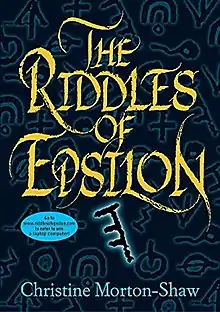The Riddles of Epsilon
The Riddles of Epsilon is a young adult fantasy novel by the British author Christine Morton-Shaw. It was first published in the USA by the Katherine Teegan imprint of Harper Collins publishers (April, 2005). It later appeared in the UK (October, 2005) and Italy (February, 2006).[1]

Plot Summary
Jess is not pleased when her parents drag her off to live on the weird little island of Lume. But then she encounters an eerie presence in an abandoned cottage, and her anger turns to fear when it begins to lead her through a series of creepy riddles. As she slowly unravels the mysteries of Lume, she finds the writings of Sebastian, a boy who lived one hundred years ago and whose life contains unsettling reflections of her own. To her horror, the dangers he unearthed in 1894 now begin to threaten Jess and her family . . . and if Jess does not unlock the riddles in time, she may lose her mother forever.
Themes
The novel deals with the ideas of good and evil found in most fantasy fiction, whilst also blurring the lines between the two and asking questions about whether evil is easy to identify. Family discord and the importance of family is another key theme, as is the importance of courage. The novel also has a preoccupation with the passage and nature of time.
Critical reception
The Riddles of Epsilon received many positive reviews on its publication in 2005. The Voice of Youth Advocates (VOYA) rated the novel as a "perfect ten" for both literary quality and "teen appeal". VOYA said of Epsilon, "this novel rises above cliché, shining through well-developed and intriguing characters, a tangible atmosphere and heart-stopping pacing."[2] The novel was also longlisted in the UK for the Manchester Children's book awards. Those reviews criticising elements of the novel have tended to focus on its dark atmosphere, complicated plot development and the use of a diary device through which to tell the story.
References
- Christine Morton-Shaw
- "Archived copy" (PDF). Archived from the original (PDF) on 20 November 2006. Retrieved 2 June 2008.
{{cite web}}: CS1 maint: archived copy as title (link)